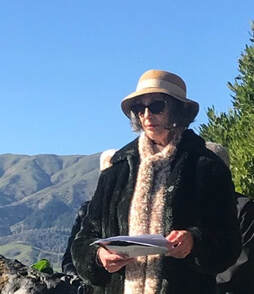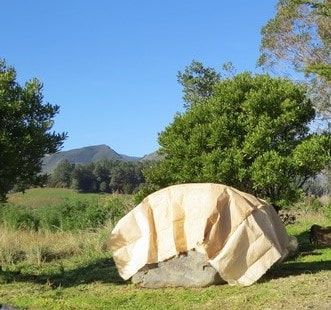Writers' Trail - Nelson/ Tasman
Helen McKinlay
|
POEM ON A BOULDER AT ROTOTAI BEACH, GOLDEN BAY
Helen McKinlay tells the story of this Rototai Environmental Arts Project:
‘I have been a regular visitor to Rototai Beach since 1981. Back then, it was dominated by the adjoining rubbish dump and the smoke from the Golden Bay Cement Works. But there were always those who appreciated its natural beauty; who loved the wonderful feeling of walking way out at low tide. Looking back from out there, one is in the centre of Golden Bay; encircled (from left to right) by the mountains of Abel Tasman National Park, the Pikikiruna Ranges, Rameka and the Takaka Hill, the view up the Motupipi inlet to Mount Arthur,and the mountains of Kahurangi National Park, which stretch round into the West Coast. And always, beyond the horizon lies the long length of Onetahua, Farewell Spit, with Mount Taranaki looming in the background. Lastly, there are the mysteries of the ocean bed and the multitudes of birds who feed there; royal spoonbills, white faced herons, pied oyster catchers, pied stilts, black shags and the rare kotuku, to name but a few. ‘Three years ago, I had a strong urge to gift my poem “Low Tide at Rototai” as a gesture of aroha to this place which had suffered so much. After much thought, I chose a boulder as its frame. I searched for a boulder people could touch and enjoy, one they could lean on as they stared out to the ever-changing views of tide and inlet. One that would have a space to place my poem on, in letters big enough for those who had left their reading glasses at home. 'I had no idea how to find a boulder, how many hours of work it would entail, how many people I would talk to, how many emails I would write, how many permissions I would need, how to approach the funding. Or, that the project would increase exponentially until it became more about the spiritual connections between people, arts and the environment. An act of kaitiakitanga. ‘On 13 July 2019 the boulder, an ancient piece of Papatūānuku from the Jurassic period, and the poem, not quite so old, were finally unveiled before a large gathering of people. Members of the Manawhenua Ki Mohua performed a karanga and waiata, and it was time for my daughters, granddaughters, and myself to lift off the harakeke covering made by Sarah Hornibrooke. I talked about the project, and then all present joined in the singing of Mozart’s version of “Dona Nobis Pacem” (Give Us Peace). Flautist Patrick Riddett played “Her Mantle is Green” (an old Irish air), and there was a final karakia before kaumatua John Ward Holmes asked people to walk up to the boulder, touch it and read the poem. My greatest wish had been that this gathering of people would be like a large dose of aroha for this place and I felt it was. There were a few teary eyes and a lot of emotion expressed before we all chatted over our cuppas under the warm winter sun. All in all it was a gorgeous Rototai Day.’ The project was funded by Golden Bay Community Trust and Creative Communities Tasman. Written by Chrissie Ward |
GETTING THERE
Once at Takaka, continue along to the roundabout at the end of Commercial Street. Go though the roundabout and continue past the High School down Rototai Road. Carry on past the cemetery on the right until reaching Nees Road on the left. Continue along Nees Road to the carpark at the end and you are at Rototai Beach. Once there, look to the right and you will see the kaitiaki boulder between two ake ake trees.
Once at Takaka, continue along to the roundabout at the end of Commercial Street. Go though the roundabout and continue past the High School down Rototai Road. Carry on past the cemetery on the right until reaching Nees Road on the left. Continue along Nees Road to the carpark at the end and you are at Rototai Beach. Once there, look to the right and you will see the kaitiaki boulder between two ake ake trees.



